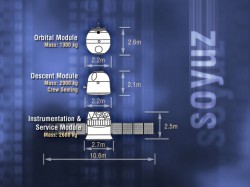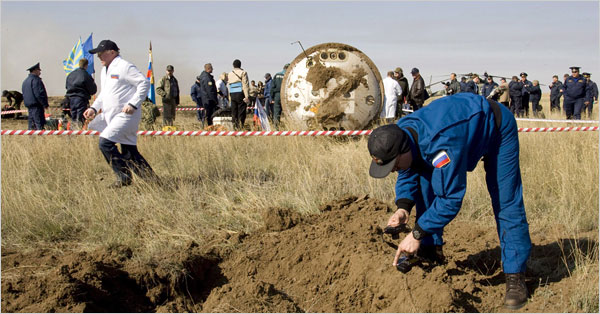Its official, last month’s Soyuz emergency landing was due to a technical fault just before re-entry. A Russian space agency official has made an announcement indicating that one of the spaceship’s modules failed to separate, putting the crew into a “ballistic re-entry”. After the event, a Russian agency source said the lives of the crew were on a “razor’s edge”, but the hardy Soyuz re-entry capsule landed the astronauts just about in one piece…

It was a rough ride when South Korea’s first astronaut, Yi So-yeon, Russian cosmonaut Yuri Malenchenko and American astronaut Peggy Whitson left the International Space Station on April 19th. At the time, the “ballistic re-entry” was shrouded in misinformation and media spin after the Russian space agency made attempts to deflect attention away from the troubled re-entry. As the dust settled a couple of days on, the facts slowly leaked though to the world’s media. Rather than re-hashing the events as they happened, check out the four days of Universe Today coverage from April 20th-24th:
- April 24th: Soyuz Hard Landing: The Facts
- April 22nd: Soyuz Capsule Hatch Nearly Burned Up and Crew's Lives Were on a "Razor's Edge"
- April 21st: New Facts Emerge from Soyuz Emergency Landing
- April 20th: Soyuz Crew Safe After a Violent Re-entry and Landing 400km Off-target
Today, the first official word from Moscow appears to confirm the initial idea that there was some problem with the separation of the descent module from another module before it hit the Earth’s atmosphere. There is no mention whether the ballistic trajectory was caused by a short circuit, and there is no blame placed on any member of the crew (originally the agency cited the Soyuz commander to be at fault, making an unscheduled course correction).
The head of the Russian manned space program, Alexei Krasnov said the Soyuz TMA-11 equipment bay module was supposed to separate after the spaceship detached from the ISS. The capsule would have then been able to smoothly enter the atmosphere for a controlled re-entry. Instead the module remained attached, forcing the ballistic re-entry. The resulting drop through the atmosphere exerted forces of several Earth gravities on the crew. It is not clear at what point the equipment module was ripped free from the descent capsule, but the crew still sustained a hard landing, making sure they will never forget that journey.
The final official report on the Soyuz hard landing is pending…
Source: ABC


Is the equipment module the same as the service module? None of the modules mentioned in the diagram have the same name as the module in the text.
Good point Ryan, I believe that the “equipment module” is the same as the instrumentation/propulsion module. Looking over the previous reports it looks like this is the case.
Cheers! Ian 😀
Posted this link in http://www.surfurls.com
This reminds me of the following…
18 January 1969 – Landing of Soyuz 5. Flight of Soyuz 4 and 5. After Shatalov and Yeliseyev transferred to Soyuz 4, Volynov remained behind to live through the most unbelievable re-entry in the history of spaceflight. The service module of the Soyuz failed to separate after retrofire. Once the Soyuz started reaching the tendrils of the atmosphere, the combined spacecraft sought the most aerodynamically stable position – nose forward, with the heavy descent module with its light metal entry hatch at the front, the less dense service module with its flared base to the back. Luckily the struts between the descent and service modules broke off or burned through before the hatch melted through and the descent module righted itself, with the heat shield to the rear, before being consumed. Due to a failure of the soft-landing rockets the landing was harder than usual and Volynov broke his teeth.
Have a look a http://www.astronautix.com.
At last, something approaching a proper explanation, none of this ‘blame it on women drivers’ stuff that seemed to be coming out at the time
(Admittedly, that may be down to cross-cultural humour not travelling well, but still………)